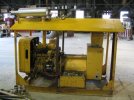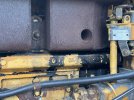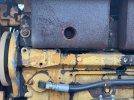Makers Acres
Well-Known Member
I have an IR SPF-56 roller compactor with a Detroit diesel 4-53. When I bought this unit, seemed to work pretty well for a few hours and then oil started to leak out of well… just about everywhere.
I did an oil change and put in Straight SAE 40 Weight oil. Found a few seals that I needed to replace and that fixed some of them. Then I sent the air compressor out for rebuilt due to the extreme amount of oil it was leaking. I also noticed that it was using a lot of oil in a fairly short time. I observed oil leaking from the connection between the exhaust manifold and the block.
I took off the valve cover and timed all the exhaust valves. Then I bought the special tool to time the injectors. I ended up noticing that the control rack could use at least one new bushing, so I replaced both. Then I proceeded to adjust the rack and set the timing for the injectors.
I pulled off the intake and noticed the rotors or compressor fins on the blower were covered in oil and debris.
Ugh.
So I sent that in for a rebuild/swap.
I noticed a large amount of oil and debris inside the engine intake and I tried to clean that the best I could.
Ended up rebuilding the top part of the governor too and setting the low and high idle correctly after all the adjustments.
She starts up even on cold days with no issues and seems to run great. However I noticed the oil leaking out of the exhaust manifold again. I have also noticed that when the engine is under load it lets off a hint of white smoke. Not sure what is normal and would love some help and suggestions at this point.
Thank you!
I did an oil change and put in Straight SAE 40 Weight oil. Found a few seals that I needed to replace and that fixed some of them. Then I sent the air compressor out for rebuilt due to the extreme amount of oil it was leaking. I also noticed that it was using a lot of oil in a fairly short time. I observed oil leaking from the connection between the exhaust manifold and the block.
I took off the valve cover and timed all the exhaust valves. Then I bought the special tool to time the injectors. I ended up noticing that the control rack could use at least one new bushing, so I replaced both. Then I proceeded to adjust the rack and set the timing for the injectors.
I pulled off the intake and noticed the rotors or compressor fins on the blower were covered in oil and debris.
Ugh.
So I sent that in for a rebuild/swap.
I noticed a large amount of oil and debris inside the engine intake and I tried to clean that the best I could.
Ended up rebuilding the top part of the governor too and setting the low and high idle correctly after all the adjustments.
She starts up even on cold days with no issues and seems to run great. However I noticed the oil leaking out of the exhaust manifold again. I have also noticed that when the engine is under load it lets off a hint of white smoke. Not sure what is normal and would love some help and suggestions at this point.
Thank you!



